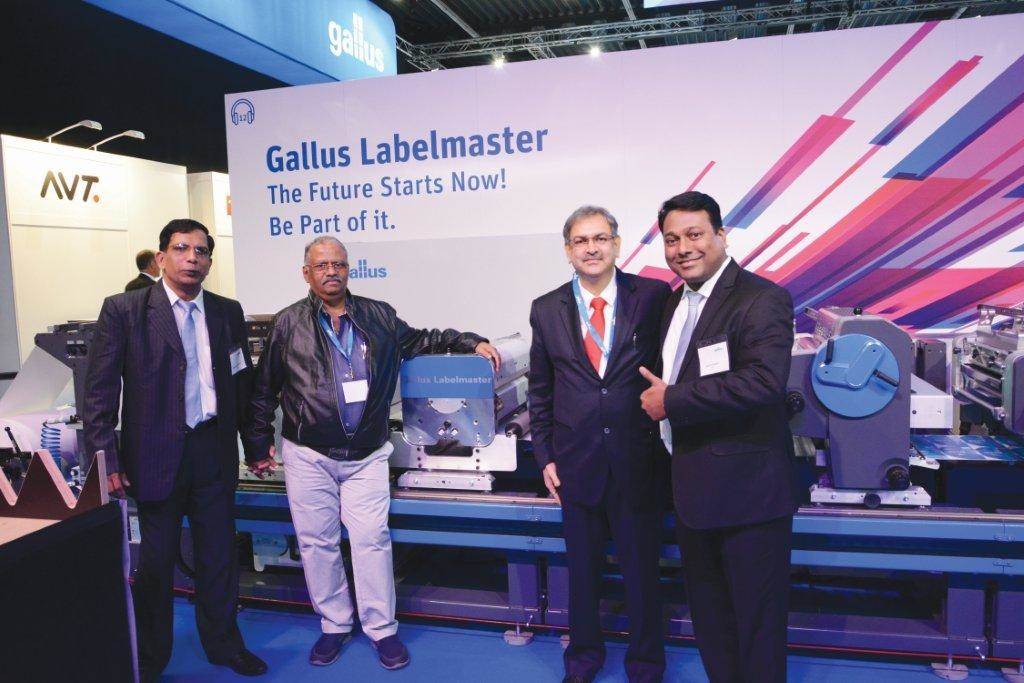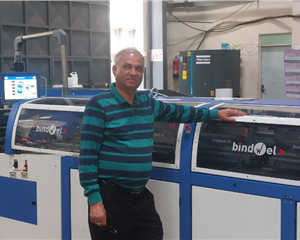Label masters debate Gallus new move
Gallus showcased a prototype version of the Labelmaster during the Gallus Innovation Days at its St Gallan plant. Noel D’Cunha, who attended the event, talks to two Indian label masters – Gururaj Ballaward of Wintek and Manish Desai of Mudrika Labels – to discuss what's different about the new Gallus offering.
26 Jun 2011 | By Noel D'Cunha
PrintWeek India (PWI): A new Labelmaster machine, new opportunities, a new way of producing labels?
Manish Desai (MD): The best part of the Labelmaster is the size – 440mm. The Indian flexo market operates in the 340mm to 380mm sizes. With this press, multiplication of ups is a possibility, which can increase production. The speed too is up to 200 mtrs/min. We normally don’t print in higher speed, but a higher speed will ensure better stability and good quality. The straight path from infeed to outfeed has brought the makeready waste down to 20meters. Gallus has returned to aircool UV lamps, which I think is a welcome change.
Gururaj Ballaward (GB): After a gap of six years, Gallus has come up with a new flexo press, and a much awaited development, I must say. The speed, the overall construction of the machine is attractive. And without auto-registration, the machine was running at a high speed producing high quality labels.
PWI: Among the new features are the use of light aluminium printing cylinders and an optimised ink duct for the chambered doctor blade…
MD: The new system will need just 250gms of ink. Also I noticed there was hardly any foaming or ink spitting, which is a big advantage.
As for the aluminium prnting cylinder, I must say that the best part is that the printing cylinder with the Labelmaster will be available from sizes 8-inch to 25-inch as against the 10-20-inch available with other machine manufacturers. For smaller jobs one can use smaller cylinders, making the press very flexible to use.
While use of aluminium has certainly reduced the weight, the hollow design, has also helped it reduce the weight further. Handling a 25inch cylinder was very easy. The top-loading cylinder system has made removal and replacement of cylinders easy. It will save time.
GB: By optimising the ink duct to use 250gms of ink means, one can easily run short-run jobs, reducing ink wastages.
PWI: In terms of applications, how does the wide width of the press help?
MD: I can give you an example of lamitubes. In lamitubes, the size of the labels is big, so if a 340mm machine will give you two-ups, a 440mm press will obviously give three-ups. This will reduce the run time while increase productivity. Plus it will be helpful in producing shrink-sleeves with multiple ups.
GB: The 440mm width will not only print labels, but also provide an opportunity to produce flexible packaging.
While there are production benefits, the extra large plates and dies add up to the cost.
PWI: Gallus claims that it’s a solution for high-quality packaging and label applications. That means it can run both film as well as paperboard?
GB: Well if it does, it is well and good, though we have not seen the press produces soft carton jobs. These are initial days for the press, though the name suggests it’s a label press.
PWI:Gallus also claims it has the ability to multiple processes?
MD: Multiple processes like screen printing, hotfoil, coldfoil, relam-delam are must-haves. The modular approach means all the process can be added as per the requirement.
GB: When the ECS was unveiled, we saw it as a prototype. Processes were added and it has now become a very popular press for Gallus.
PWI: RCS Vs Labelmaster?
GB: The RCS is a fully-loaded machine, and an expensive kit. For the Indian label industry it will be either the ECS or the Labelmaster. From my point of view, the Labelmaster is a good alternative for the RCS, at least in the Indian market.
MD: The RCS is in a completely different league, servo-motor driven and loaded with all the processes. The Labelmaster has limited servos, but a shaftless machine. The Labelmaster is a bigger version of the ECS, but without the granite.
PWI: The granite was the USP of the ECS 340. Are you happy that the Labelmaster does not have one?
MD: Lookwise, the ECS, because of the granite, has a better aesthetic feel. However, I think, the width did not allow use of granite.
PWI: The speed, stability, and quality of the Labelmaster?
MD: Gallus ECS is the only machine with a stone back. The Labelmaster is a machine with a regular frame structure. Only a sturdy frame can deliver a speed of 200 mtrs/min. Also the sound of the machine running that speed shows that it’s a pretty sturdy machine.
GB: At the demo, we saw the operators change three jobs in formats of 18inch and 25inch in about ten minutes. There was no need to set the pressure of the machine even for different substrates. This inherent automation will effectively reduce the makeready time.
PWI: To become a label printer is very easy than becoming a packaging solution provider. How will the Labelmaster help a label printer become a packaging solution provider?
GB: The labelmaster can print on multiple substrates, so a label printer does not need to invest in a sheetfed press to print say mono-cartons.
MD: Let me tell you one thing. We produce cartons using sheetfed offset, and I understand the carton business. Printing cartons on a label press is going to be a different ball game. Labelmaster may be capable, but despite its width, size will still be a limitation as far as cartons are concerned. However, it will be good for cut-labels, flexible packaging, lamitubes, etc, which are also packaging solutions.
PWI: Will Labelmaster be a machine, that offers the packaging converters an opportunity to dive into labels?
GB: As long as the new players are able to maintain margins on their print jobs, there is scope of doing business. Whether it is an ideal machine for the new players, depends on the capacity of the investment, the model and the cost in the Labelmaster series they are looking for.
PWI: Every manufacturer now has a digital label press. Gallus too has one in the LabelFire. But digital is one thing that has not caught up in India. Why?
MD: The cost of investment. Plus, take any digital press; it becomes obsolete in a couple of years. We are waiting for a digital press that will last at least half the life of a flexo press.
GB: Like some types of print jobs have moved from commercial or screen to digital. Visiting cards and invitation cards are prime examples. Certainly there will be jobs that will move to digital even in labels, and digital time in India will come.
Further, the difficult with our brands here is that they want the quality of digital to match the flexo and vice-versa. In Europe and the US, they are accepted as digital and flexo prints. When the brands change the way they see flexo and digital is when digital will become popular.
MD: I think digital has a different market segment – the customers are different. The customers in India are not demanding variable printing, and the like.
PWI: Would you invest in the Labelmaster? How soon or far will it be?
MD: Our strategy is to wait and let the machine stabilise in the market.
GB: I’ve already invested in a label machine and my next investment will be next year, perhaps during the Labelexpo Europe.
PWI: Your verdict on the Labelmaster?
MD: I had expected to see a bigger size machine but on a granite platform. But I think it’s a good move by Gallus to bring in a new press, where perhaps there’s a need for one. I hope they add a unit or two of gravure.
GB: I was aware that this time it will not be a digital press. After a long time Gallus has come up with a flexo press, that promises to be affordable.
Gallus unveils a new wide, fast flexo press series
Gallus’ newest offering, the Labelmaster, is its widest and fastest flexo press, and as it claims, “can be configured by customers to meet their own specific requirements”.
Gallus, a Heidelberg-owned subsidiary, showcased the 440mm (17-inch) flexo machine platform that can run at a speed of 200m/min to a group of journalists on 19 September, a day ahead of the second Gallus Innovation Days at its plant in St Gallan. The first was held in September 2014.
Still a prototype, the Labelmaster is made up of two modules, each comprising of two printing units driven directly by two servo motors. The press will be available in three different variants – a basic version, “Classic” covering all the required standards for label printing; a more flexible “Plus” version; and the “Advanced” version configured to meet higher needs in the level of automation.
The modular system offers among other things, a new locking system that Gallus claims, makes it easy to change printing units accurately.
Gallus, however, did not disclose the pricing of the new press.
Among the new features are the lightweight aluminium printing cylinders, a short web path of 1.1m from printing unit to printing unit, and an optimised ink duct for the chambered doctor blade which needs just 250gms of ink.
It can also be equipped with the newly developed screen printing unit. The press supports a wide range of substrates – from paper and PE to PP and foil.
The Labelmaster is currently under test at an unnamed customer site in Switzerland, and the first series deliveries are scheduled for the second quarter of 2017.















 See All
See All